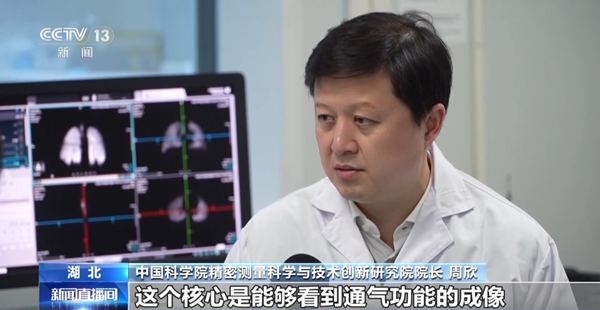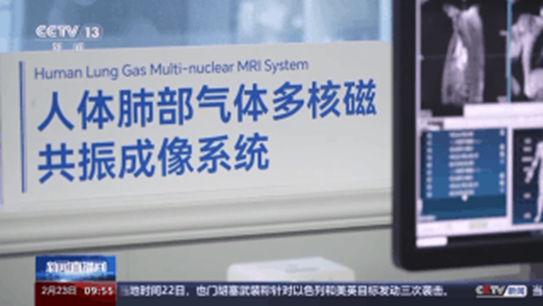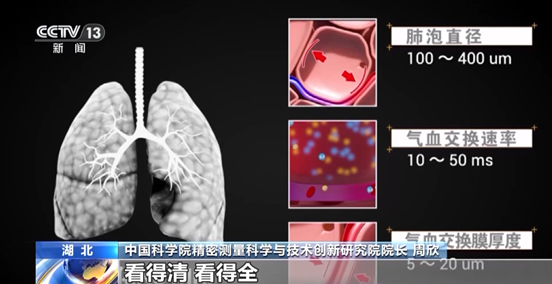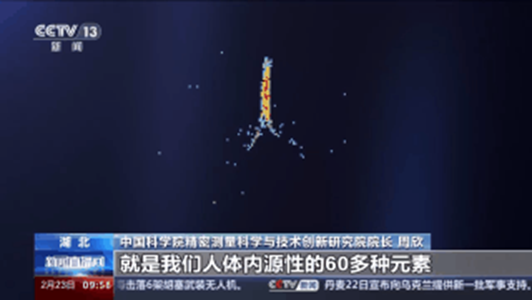

[CCTV13 News] New Breakthrough in Lung Magnetic Resonance Technology: Sampling Time Reduced to 3.5 Seconds
As the Lunar New Year of the Dragon begins, a series of national major scientific research instruments and equipment are being vigorously developed, focusing on breakthroughs in key core technologies. Recently, at the Innovation Academy for Precision Measurement Science and Technology, the Ultrasensitive Magnetic Resonance Research Group has been making continuous efforts in magnetic resonance imaging, achieving a series of new technological breakthroughs.
By inhaling a specially designed "xenon gas," a 3D magnetic resonance image of the human lung can be obtained in just 3.5 seconds. In the images, the areas of the lungs that the gas reaches are clearly visible, along with the lung's microstructures and health status at a glance. Fast sampling and precise imaging represent an innovative breakthrough by the Xin Zhou group at the Innovation Academy for Precision Measurement Science and Technology, turning what was once a "blind spot" in magnetic resonance imaging of the human lungs into an increasingly clear picture.

Xin Zhou, President of the Innovation Academy for Precision Measurement Science and Technology at the Chinese Academy of Sciences: After the Spring Festival, we are now focusing on ultra-fast, high-resolution imaging of lung gas. The core is the imaging of the ventilation function, showing where the gas is breathed in, allowing us to see it at a glance. The second is the gas-blood exchange function, which is whether the gas we breathe in actually goes into the blood in the alveoli. This is actually closely related to many diseases and was not obtainable with traditional clinical imaging techniques.
Traditional magnetic resonance imaging uses water protons in the human body as the signal source, while the human lungs, filled with gas, represent the only imaging "blind spot" for magnetic resonance and a major challenge for the scientific community. How to illuminate the lung "black hole"? The research group shifted their approach, developing gas multi-nuclei magnetic resonance technology in an attempt to break through this visual "blind spot."

After more than a decade of effort, the research team used xenon, a non-toxic, inhalable inert gas, as the signal source, and through independently developed key core technologies, they enhanced the magnetic resonance signal by more than 50,000 times, successfully "illuminating" the lungs and making imaging faster and clearer. In August 2023, the human lung gas multi-nuclei magnetic resonance imaging system was the first to be approved for market, providing new equipment for early screening, treatment, and research of lung diseases. This Spring Festival, the research team made a breakthrough in the new generation of lung imaging rapid sampling technology, reducing the sampling time from the original 6 seconds to 3.5 seconds and significantly improving the spatial resolution of the images.

Xin Zhou, President of the Innovation Academy for Precision Measurement Science and Technology at the Chinese Academy of Sciences: From not being able to see to being able to see, and now to seeing everything clearly, we can now see with higher spatial resolution. In the future, perhaps when you go to a hospital for lung function imaging, it will be as clear and comprehensive as a routine blood test.
Currently, the research group is accelerating the development of clinical magnetic resonance imaging technologies for more atomic nuclei such as sodium and phosphorus, advancing deeper into science.

Xin Zhou, President of the Innovation Academy for Precision Measurement Science and Technology at the Chinese Academy of Sciences: Traditional magnetic resonance is like a black and white photo, while multi-nuclei magnetic resonance is like a color photo. The more than 60 endogenous elements in our body can be thought of as different atomic nuclei, equivalent to different colors, just like the optical spectrum from red to violet. Thus, the magnetic resonance images produced will also be colorful, providing doctors with more information for diagnosis and treatment. To seize the technological high ground and serve the major needs of the country, benefiting the people, is our goal.
(Reporters Meimei Ren and Lixia She from CCTV)

Innovation Academy for Precision Measurement Science and Technology, CAS.
West No.30 Xiao Hong Shan, Wuhan 430071 China
Tel:+86-27-8719-8631 Fax:+86-27-8719-9291
Email:hanyeqing@wipm.ac.cn
鄂ICP备15017570号-1